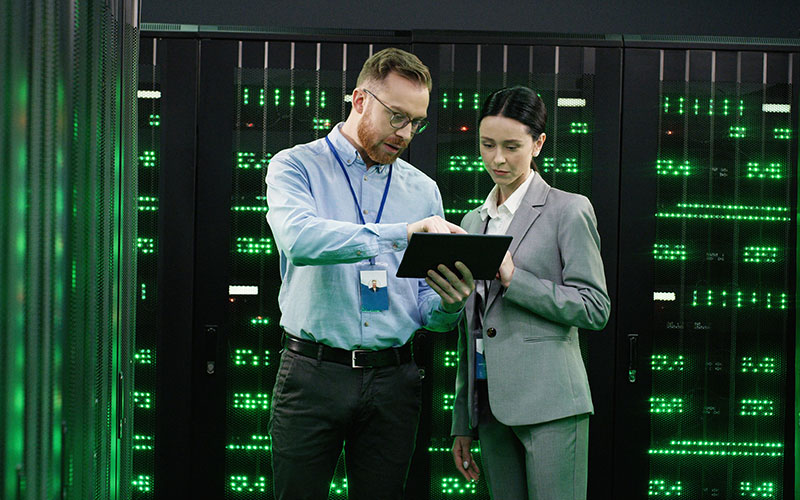Insights
- Many of the world’s largest companies still rely on traditional mainframe systems with more than 70% of the Fortune 500 operating their core businesses on mainframes and nearly 90% of the world’s credit card transactions handled by mainframes.
- Modernization offers benefits such as business agility, rich end-user experience, digitization opportunities — such as advanced analytics and reporting — and lowers annual application maintenance costs by an average of 40%.
- Mainframe modernization reduces costs in two main areas. For functionality that needs to remain on a mainframe, the code can be optimized to make it less processor-intensive. Functionality that can be reproduced in the cloud, such as reporting or analytics running on open-source products, can significantly reduce licensing costs and provide a rich set of insights.
- By reengineering applications into microservices, companies can achieve a reduced time to market and a reduction in the consumption of mips. Infosys modernized the customer data management for a U.S. bank, which reduced mips consumption from 30,000 to 12,000 and provided a more comprehensive view of customer data.
- Mainframe modernization seeks to transform the current installation into next-generation architecture that can boost resilience. According to an IDC survey, respondents said they reduced hardware capital expenditures by an average of 6.8%, software costs by 2%, and staffing by 1%.
Even as technology accelerates, many of the world’s largest companies still rely on traditional mainframe systems that use 60-year-old programming languages. More than 70% of the Fortune 500 operate their core businesses on mainframes, according to research by Forbes.1
Despite the continued usefulness of these systems, there are growing challenges to maintaining infrastructure and applications designed for earlier-generation technology. Companies face important decisions about modernizing their mainframes to save costs and introduce new capabilities.
Even businesses that don’t have mainframes often rely on them on a daily basis. These systems are still widely used by manufacturers, retailers, financial institutions, insurance companies, and government agencies. Nearly 90% of the world’s credit card transactions are handled by mainframes.2
However, core functions cannot change rapidly enough to adjust to market demands. And it is increasingly difficult to find experts to work on these systems, which increases business risk. As companies seek to become more resilient, responsive, and relevant, they often conclude that mainframe modernization is the best solution — one that can reduce computational loads, lower licensing fees, and create more adaptable applications.
Mainframe benefits and drawbacks
Mainframes have dominated business computing for obvious reasons: They are great at handling large numbers of processes and computing vast amounts of data. This technology is also particularly good at problems that require scaling up (more sequential processing) compared to problems more suited to scaling out (more parallel processing).
The drawbacks are equally obvious, including the high initial cost, charges for computing overages, and shrinking pool of talent that can maintain mainframes. IBM has projected there would be as many as 84,000 unfilled mainframe jobs.3
Mainframe costs are determined by the amount of computing power needed to perform tasks. The price of this computing power varies from $1,000 to $4,000 per million instructions per second (mips). On average, a typical 2,000 mips mainframe system costs more than $4 million.
That investment, however, is just the starting point. The computational load placed on a mainframe is often variable. For example, retailers process more transactions during holidays and weekends, which pressures them to acquire more mainframe capacity than they would need on a typical business day. The lack of automation to scale up and down causes retailers and businesses like them to incur additional costs.
Because of the high per-mips cost, it is more economical for companies to purchase a system that handles their typical needs and then pay for more computing power temporarily from their provider. Growing business needs could increase mips consumption by at least 5% annually. In addition, there are licensing costs for software tools, labor maintenance costs, and application upkeep costs — all of which can add up to about $9 million over a decade.
Many of the mainframe applications are written in COBOL and in proprietary languages that are not commonly used today outside of mainframes. Expertise is dwindling as people who learned these languages as young programmers now approach retirement age. Meanwhile, there are still an estimated 220 billion lines of COBOL in use worldwide.4
In April 2020, New Jersey Gov. Phil Murphy publicly pleaded for more COBOL programmers.5 The state needed help upgrading its unemployment insurance system — built with the 60-year-old language — to accommodate a surge in workers who had lost their jobs due to the COVID-19 pandemic.
Furthermore, some applications on mainframes have significant amounts of redundant code because of how they were originally designed. A change to one function means a change to every place in the code where that function is repeated. This makes enhancing application functionality difficult and time-consuming.
The case for modernization
All these challenges put pressure on companies to reduce their reliance on mainframes. The option to do nothing is the easiest, but that approach is likely more expensive over the long term and certainly increases future risks. Modernization offers benefits such as business agility, rich end-user experience, digitization opportunities — such as advanced analytics and reporting — and lowers annual application maintenance costs by an average of 40%. An IDC survey of IBM Z users that modernized their systems found that 73% added artificial intelligence capacity and two-thirds added hybrid cloud and Internet of Things initiatives.6
Mainframe modernization does not require the complete replacement of existing infrastructure with different on-premises hardware, or even moving the entire operation to the cloud (although it can). The first step toward modernization is to analyze the current mainframe usage. It is important to understand dependencies, computationally intensive jobs, which applications can be rehosted elsewhere, and the business rules that govern how applications behave. The assessment phase of modernization is crucial to get right because it determines the road map for how much mainframe computing should be retained, whether certain code is transferred, and how any new applications will relate to each other and the existing system.
Mainframe modernization does not require the complete replacement of existing infrastructure
Each factor influences the complexity and the time needed for completion, which ultimately affects the cost. One Infosys client, a global automobile manufacturer, had an inventory of 73 separate applications with over 22 million lines of code that were used to create its modernization road map.
Mainframe modernization reduces costs in two main areas. For functionality that needs to remain on a mainframe, the code can be optimized to make it less processor-intensive. That leads to lower overall mips consumption. Functionality that can be reproduced in the cloud, such as reporting or analytics running on open-source products, can significantly reduce licensing costs and provide a rich set of insights. Infosys helped an Australian retailer save more than 50% on its core merchandising and inventory management systems by moving the company from a mainframe to Micro Focus Enterprise Suite on Amazon Web Services. This technique helped the retailer become more relevant to its customers.
Modernization also increases organizational agility by using DevOps, APIs, and batch modernization. DevOps creates a continuous integration and delivery pipeline for all software so that updates are more easily automated, tested, and deployed.
Infosys helped a U.K. bank implement DevOps on a mainframe system for its core banking portfolio, which reduced its cycle time by 30% and created $3 million worth of benefits as well as increased responsiveness. Batch modernization moves processes that scale-out better — such as extract-transform-load operations on a database — and streamlines them in a more parallel process. Infosys had one global credit card company achieve a 40% reduction in its transaction time with batch modernization. Removal of repeated code and use of APIs make future application changes much easier to implement. Additionally, code reuse allows parent companies to maintain a consistent user experience across regional brands.
Finally, mainframe modernization seeks to transform the current installation into next-generation architecture to increase resiliency. By reengineering applications into microservices, companies can achieve a reduced time to market and a reduction in the consumption of mips. Infosys modernized the customer data management for a U.S. bank, which reduced mips consumption from 30,000 to 12,000 and provided a more comprehensive view of customer data.
Which of these processes will benefit you most? The basic flowchart in Figure 1 below maps out likely endpoints based on your answers to six simple questions.
Figure 1. The most likely way to modernize your mainframe
Mainframe modernization seeks to transform the current installation into next-generation architecture that can boost resilience
For companies that decide on modernization, the benefits are clear. In the IDC survey of mainframe users, respondents said they reduced hardware capital expenditures by an average of 6.8%, software costs by 2%, and staffing by 1%.7 Companies that have not considered updating their mainframe systems in the past several years, however, will face escalating costs and complications if they choose to do nothing. But complete replacement often isn’t cost-effective or even feasible. Savvy IT departments in these circumstances will evaluate their mainframe situation and look beyond binary choices.
References
- From Shopping To Space Travel, How The Mainframe Changed Our World, Pat Toole, April 8, 2014, Forbes.
- IBM unveils new cloud-ready mainframe based on single-frame design, Ross Mauri, April 10, 2018, IBM.
- Mainframe Modernization and Skills: The Myth and the Reality, Emily Farmer and Michael Casile, 2014, IBM.
- Progression from Fujitsu: Mainframe modernization on AWS and Azure, Fujitsu.
- As Unemployment Claims Spike, New Jersey Seeks COBOL Coders, Ben Miller, April 7, 2020, Government Technology.
- New research proves that modernizing legacy platforms drives legendary results, Rocket Software.
- New research proves that modernizing legacy platforms drives legendary results, Rocket Software.





